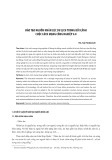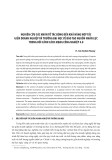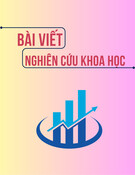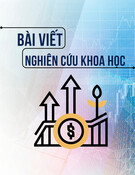
106 Green technology application policies for sustainable development:…
GREEN TECHNOLOGY APPLICATION POLICIES
FOR SUSTAINABLE DEVELOPMENT: INTERNATIONAL
EXPERIENCES AND LESSONS FOR VIETNAM
Bui Ngoc Thu Ha
1
National Institute for Science and Technology Policy and Strategy Studies
Summary:
On a global scale, science, technology and innovation (STI) are expected to play an important
role in realizing sustainable development goals (SDGs). However, in reality, STI has not been
closely linked to the SDGs, as shown by the fact that most research and innovation efforts do not
focus on sustainability. This article examines the experiences of three countries: China, India,
and Malaysia. Lessons learned from these countries show the need for a comprehensive green
technology program, and financial and non-financial support policies from the state to promote
research and development (R&D), raise public awareness, and flexibly adapt to the domestic
context. They are the key elements for Vietnam to promote green technology application, towards
long-term sustainable development.
Keywords: Technology application policy; Sustainable development; International experiences.
Code: 24121201
1. Introduction
Science, technology and innovation (STI) have long been recognized as
indispensable in improving economic performance and enhancing
competitiveness. Also, STIs help address environmental and social
challenges and improve the quality of life. Technology has the potential to
significantly boost efficiency, increase productivity, improve access to
services, enable data-driven decision-making, and promote sustainable
practices in various sectors, including energy, agriculture, health, education,
and infrastructure. Technological advances, such as those in renewable
energy, digital connectivity, precision agriculture, and sustainable urban
planning, can contribute to sustainable development by promoting economic
growth, social inclusion, and environmental sustainability.
Technology application policies for sustainable development include aspects
such as building a comprehensive program system, financial and non-
financial support policies, promoting R&D, and raising public awareness. In
addition, the promulgation of regulations and legal frameworks to encourage
the development of environmentally friendly technology and minimize
negative societal impacts is also an important aspect of this policy.
1
Author’s contact: buingocthuha26@gmail.com

JSTPM Vol 13, No 3+4, 2024 107
The application of technology for sustainable development requires
appropriate and effective policies from the State to promote innovation while
ensuring a balance between economic growth, environmental protection, and
social development. However, the process of developing and implementing
technology application policies for sustainable development still faces many
challenges, including the complexity of technology management, financial
and human resources requirements, and the need for flexible adjustment to
accommodate constantly changing economic, social, and environmental
conditions.
STIs in Vietnam have not yet clearly demonstrated their role in the process
of implementing sustainable development goals. Therefore, the objective of
this article is to study the experiences of some countries in the world
regarding technology application policies for sustainable development goals
and draw lessons for Vietnam.
2. Status of Vietnam’s science, technology and innovation activities for
sustainable development goals
According to Dang Thu Giang (2019), STI play a key role in promoting the
implementation of sustainable development goals set by the United Nations.
According to the 2030 Agenda (Agenda 2030), this role is most clearly
affirmed in Goals 9 and 17, as STI is not only the main driving force for the
economic transformation process towards prosperity, inclusiveness, and
environmental sustainability but also the foundation for promoting
sustainable industrialization and enhancing technological innovation
capacity. Not only does it increase efficiency and diversify the economy, STI
also contributes to establishing modern infrastructure, improving
productivity and competitiveness, reducing poverty, improving food security
and nutrition, and developing sustainable agriculture. In addition, STI
applications facilitate access to clean energy, improve the quality of health
services, prevent diseases, ensure social equality with the principle of
“leaving no one behind”, and promote flexible and personalized access to
education. Through international cooperation and establishing global
partnerships on STI (according to Goal 17), countries can strengthen their
capacity to address economic - social - and environmental challenges,
thereby strongly supporting the implementation of the “Agenda 2030” on a
global scale.
To date, despite being expected to serve as an important driving force, STI
have not yet fully played their role in implementing sustainable development
goals due to a lack of connection with practical needs, limited incentive
policies, as well as ineffective implementation and application capabilities.
A recent study by the University of Sussex has pointed out the
incompatibility between STI activities and the SDGs. In high- and middle-
income countries, most research and innovation activities are not closely
linked to the SDGs, as shown by the fact that 60% - 80% of scientific

108 Green technology application policies for sustainable development:…
publications and 95-98% of innovation activities are unrelated to these goals.
Furthermore, 80% of SDG-related innovations in wealthy countries are
concentrated in only 6 of the 73 countries, with the United States alone
accounting for 47% of all innovations (Ciarli, 2022).
This study has identified several reasons why STIs have not fulfilled their
role in implementing Agenda 2030, notably issues related to the orientation
and application of STIs to address current pressing sustainability issues:
First, the issue of orientation: Most of the published research (60% - 80%)
and patented activities (95% - 98%) are not aligned with the SDGs. This
shows the lack of connection between the STI direction and the global
sustainable development goals.
Second, the issue of inequality: In high-income (HICs) and upper-middle-
income countries, only 30% - 40% of research is related to the SDGs.
Meanwhile, in low-income countries (LICs), 60% - 80% of research is related
to the SDGs but only counts for 0.2% of the global total research. This is
because most of the global research is conducted in HIC countries without
collaboration with researchers in LICs - where the SDG challenges are most
severe. As a result, opportunities for STIs to address the context-specific
challenges of disadvantaged countries are limited.
Third, the issue of focus: Although most stakeholders consider social
innovation activities and policies to promote innovation at the central and
local levels to be important in addressing the SDGs, support for these types
of innovation and research related to social issues such as poverty, inequality,
and conflict still lags behind research and investment in advanced
technologies.
Fourth, the problem of knowledge separation: There is currently little effort
to translate research results into innovations to address complex social
problems. In addition, there is some evidence that STI activities have both
positive and negative impacts on the SDGs.
Fifth, the problem of mismatch with regional needs: National research
priorities are often poorly aligned with regional SDG challenges. This is the
case in lower-middle-income countries such as India (which does not
prioritize research on hunger or gender equality), and in most HICs, such as
the United States, which does not prioritize research on key environmental
challenges related to unsustainable consumption and production patterns.
Globally, military-related research often receives significant funding, even
though military objectives are not mentioned in the SDGs (Ciarli, 2023).
The above five issues reflect the public goods nature of STI activities, which
are non-exclusive and non-rival when there are many users, such as clean air
or a healthy environment. Because these benefits cannot be monopolized or
commercialized easily, private enterprises often lack the motivation to invest

JSTPM Vol 13, No 3+4, 2024 109
due to difficulties in recovering capital and profits. In addition, the benefits
of sustainable development are often positive externalities, not fully reflected
in market prices, resulting in the market failing to properly assess the true
value of these solutions. As a result, investment and interest from the private
sector in STI projects serving sustainable development goals are limited,
although they bring great benefits to society.
In Vietnam, according to Nguyen Quang Tuan (2016), the commercialization
of research results in areas serving the poor and economically disadvantaged
regions also faces many challenges, mainly because beneficiaries often
cannot afford new products or technologies. Farmers in developing countries
are a typical example: they need scientific and technological solutions to
improve productivity and cope with problems such as pests or climate
change, but their limited income prevents them from purchasing these
products. This leads to the market for research results in that field being
almost non-existent, making it difficult for scientific and technological
organizations to have the motivation to commercialize and recover
investment capital.
Not only does the supply side of green technology face many difficulties, but
the demand side of green technology also encounters numerous barriers to its
application and use in the production chain. According to the analysis of Xia
et al. (2019), when businesses consider applying green technology to their
operations, they often face a series of different barriers that slow down or
even hinder the transition process, specifically outlined below:
Technological barriers: Technically, green technology is often complex and
requires deep expertise. However, a scarcity of high-quality human resources
makes it difficult for businesses to maintain and operate new systems. In
addition, the lack of supporting information technology applications (such as
monitoring software and data management) and the lack of synchronized
infrastructure make the green technology deployment process costly and
time-consuming to upgrade or adapt.
The production barriers: The production process also encounters obstacles
when integrating green technology. First, product design is often not
optimized for environmental standards, forcing businesses to modify their
designs or structures, which increases costs and reduces competitiveness. In
addition, the lack of technical data, environment, and quality standards
makes it difficult for businesses to plan long-term, slowing down progress or
even causing them to abandon green ideas. The cost of replacing green
materials and components is often high, and the supply is limited, creating
financial risks. Furthermore, uncertainty regarding capital recovery and
commercial benefits makes businesses hesitate to invest in new technology.
The management barriers, corporate culture, institutions, and markets:
Regarding management, senior leaders often fail to view the environment
and green technology as strategic goals, resulting in insufficient resource

110 Green technology application policies for sustainable development:…
allocation and a lack of clear objectives. Employees often lack information
and training and are unaware of their responsibilities in green transformation.
Poor internal communications leave them confused and uncooperative. In
addition, the lack of environmental priorities makes green activities easy to
be sidelined. From a policy perspective, inconsistent or constantly changing
regulations create additional risks, while businesses lack financial support,
public infrastructure, and stakeholder commitment. If consumers are
unwilling to pay more for green products, or the supply chain is
uncooperative, the process of adopting green technology becomes even more
difficult.
In the context of green technology applications facing many barriers from
both supply and demand sides, or in other words, the science and technology
market is facing many “market failures”, the role of the State becomes
extremely important to correct market failures with appropriate policy tools.
In terms of technology provision, the State can support by building a
comprehensive program system, including clear and stable regulations and
standards, providing businesses with a solid legal foundation to invest in and
develop green solutions. The State can also promote investment in basic
infrastructure (renewable energy systems, green transport networks,
environmental information databases) and improve science and technology
capacity through direct and indirect funding of R&D activities, encouraging
innovation at institutes, research centers, and universities. This helps reduce
technical and economic risks and facilitates the development, improvement,
and commercialization of domestic green technology.
In addition, on the demand side, the State plays a role in guiding and
stimulating the market. Financial support policies such as tax incentives,
credits, or funds to support businesses applying green technology can
encourage businesses to confidently innovate production lines and improve
technology. At the same time, the State can use non-financial policies such
as communication and education to raise public awareness of the economic,
social, and environmental benefits of green products and services, thereby
promoting market demand and motivating stakeholders to adopt clean
solutions. The State can also act as an intermediary, connecting supply
chains, and establishing an interactive platform between businesses,
researchers, and customers to promote cooperation, sharing knowledge,
experience, and green initiatives.
3. International experience in developing policies for the application of
green technology for sustainable development goals
3.1. China's experience
In recent years, China has issued many specific policies to promote the
application of green technology, thereby supporting the transformation to a


























